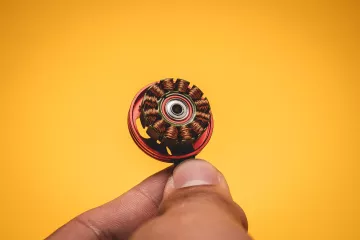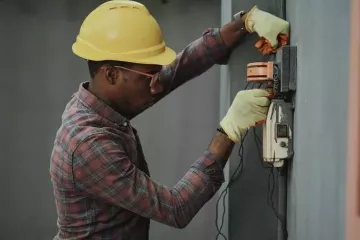Smart composite solution for real-time NDT and predictive maintenance
If a composite material can be defined as a combination of two or more distinct materials to attain new properties that can not be achieved by those of individual components acting alone", then it is only natural that production errors and material flaws will occur, as in every other manufacturing process. These composite material flaws can have a butterfly effect on the whole structure, which not only can bring tragic outcomes in the safety-critical applications but can also damage the economic health of the composite manufacturer and subsequently assembly companies.
Composite materials are fundamentally distinguished by polymer science between thermoset and thermoplastic composites. Thermoplastics are softened when heated and can be later re-melted and reúformed, whereas thermosets are put through a chemical reaction when heated which is commonly called curing, and is irreversible. Both are important for their application demands and requirements and open up different yet exciting opportunities!
Based on this distinguishing method of the composite materials we can also clarify their manufacturing methods
Thermoset Composites Manufacturing Methods:
- Hand layup – resin coat is applied on a material surface, after which i.e. a fabric reinforced material is placed
- Vacuum bag – laminate layup is covered with an airtight bag, after which the air is removed and the material is cured (20–40 degree) under 1 bar pressure Autoclave – similar to the method above this process also is in a vacuum. A material layup (i.e. the mould, prepreg, peel ply, vacuum bag) is placed in an autoclave where vacuum, temperature and pressure on the material can be controlled
- Resin injection – In this method the mould usually consists of top and bottom parts, and the space in between has the design and thickness of the desired final product. Reinforced materials (fabrics, mats, etc.) are placed in between the two moulds in dry plates. The resin is then injected and cured in 25–40 degree celsius under 1 bar pressure.
- Pultrusion – In this method a material is pulled through a die (resin).
- Filament winding – Dry spulls / creel of the material is pulled through a comb, after which the material goes through resin bath and nip rollers, and winded on a rotating mandrel on a desired shape.
- High and low temperature compression moulding – similar to resin injection this method requires moulds that consist of upper and lawyer halves and have the desired shape of a final product – when a resin is injected from the lawyer half, a staple is placed – pressure then shapes the desired form of the final material
Thermoplastic Manufacturing methods:
- Automated Tape Laying (ATL) – loaded roller system lais unidirectional tapes on a mould. This helps change and control the degrees of articulation depending of the complexity of the desired final product
- Automated Fibre Placement (AFP) – significant strength is used with a machine to place multi-layered composite products, usually continuously.
- Melt impregnation techniques – usually used to manufacture laminates of sandwich assembly. Fibre from the reel goes through heating, polymer impregnation, calendering, water bath and finally pulled onto a wall.
- Hot stamping
- Super plastic forming – argon gas is injected onto the laminate which presses on a mould (the mould also has a die on the surface).
- Autoclave technique – the above mentioned autoclave technique is also commonly used to produce flat laminates
- Filament winding – to produce components with regular geometric cross sections.
Types of damages
Composite materials also undergo a variety of damages and material behaviour, which can also be specific per their type. To list the examples – common types of material behaviour and damages of carbon composites include debonding, delamination, deformation, solidification, wrinkling, matrix failure, crazing, broken fibers.
Manufacturing of anomaly detection methods are often inherent in composites, naturally, the introduction of composites into large scale production directly depends on the successful application of non-destructive testing (NDT).
NDT methods
Even though some of the current NDT methods are better in certain environments than the others, so far there isn’t introduced any “golden mean” technology, whether using the coin tapping, vibration analysis, thermography, optical, ultrasound, radiography methods or eddy current testing – various limitations occur – limited accuracy, limited penetration depth, composite surface accessibility, methods being cost-intensive or time-consuming, limited use in a dusty industrial environment, need of a vibration-free environment or being unable to determine damage severity, etc. In general – only a few of them allow real-time measurements.
For any sector professional, it’s no secret that we are living in a world where many composite-based structures are serving beyond the lifetime they were designed for and they are likely to remain in service for even longer. Many composite structures are in need of immediate attention. Their repair, maintenance, or replacement will cost millions of dollars, however, it still needs to take place.

New solutions for the composite industry
We at RVmagnetics believe – that the composite industry needs to take a new road and develop smart self-monitored composites that can provide significant added value on top of the traditional NDT methods. How?
RVmagnetics developed MicroWires – miniaturized, magnetic, contactless microsensors of physical quantities (sensing temperature, pressure, and magnetic field directly and pull, axial stress, mechanical stress, torsion, bending, vibration, etc. indirectly).
The MicroWires are composite materials themselves, they consist of metallic nucleus and glass coating. MicroWire is a passive, unpowered element. To “power” it – enable sensing and obtain real-time live data – a set of coils (powered, active element) and electronics are placed within the range of 10cm and allow contactless sensing. Without causing any material flows, or adding almost no additional weight MicroWires can be easily introducedinto composites such as carbon fiber composites, glass fiber, ceramic composites, plastic composites, etc.
They can simply be embedded between composite layers in the production process which, naturally gives you control over:
- each part of the production process (e.g. measure temperature locally not only on the surface but also in between the layers)
- random inspections and defect detections
- real-time live data about the current state of the composite (up to ten thousand times per second resolution) through the lifetime the composite is used
Solution provides a real opportunity to create self-monitored composites that reduce the likelihood of material failure, optimizes the production process to manage composite properties minimizing material and production costs, accelerating processes (composite decking, bonding, etc.) without risking cracks or other failures. In a nutshell – increasing quality level while decreasing material waste.
Combining AI with live data brings the opportunity to increase safety drastically, provide data on remaining useful lifetime (RUL) for the structure. The financial gain lays in reducing the frequency of maintenance tasks, transforming the preventive and reactive maintenance into predictive maintenance. Simply, a maintenance timetable can be created on the go.
While current structural health monitoring methods are valuable in detecting and preventing potential damages in the production process or post-production we strive for safety, real-time measurements and industry transformation towards digital. MicroWire sensing technology provides a gateway to real-time data from places that have been impossible to access thus far.
A few of the specific use cases are, for example:
Resin flow monitoring – where MicroWIres can be placed within the mold layers and, as they can sense few microns of change in a physical space – the resin flow can be clearly detected at each part where the wire is placed, moreover, during the curing process and after, during the solidification process, the MicroWire can provide real-time temperature and pressure data to confirm if the composite has been cured properly, and weather the resin is homogeneously distributed
Filament Winding – MicroWire can be supplied on a spuul as well, and be windied into the final product with the composite fibres. This gives the opportunity to have a smart sensor within a composite material and detect potential delaminations, shocks, misalignments, or – to receive data from different depth of the material – to see the distribution of stress and temperature within the depth of i.e. carbon fiber pressure vessels for hydrogen, composite rebars, etc.
Curing – a composite material needs to be cured (i.e in autoclave) within specific temperatures, length of curing and pressures applied onto the material – our sensors give the unique advantage to do the monitoring of this process directly from within, in real-time.
Wrinkling – there are limits and thresholds to certain levels of wrinkles, bubbles, that can occur within the surface of a composite material (under the fibres) – there hasn’t yet been clarified a process or system that can properly identify the wrinkles, notify the manufacturing unit and confirm the level of the error. MicroWire finds their application in a unique way here as well – by detecting the position/pressure changes when wrinkles start to appear.
If you want to explore topic of composites in detail, read our article about monitoring of composite welding.
We’re ready to partner up with like-minded companies, visionaries and R&D professionals. Are you the one?



